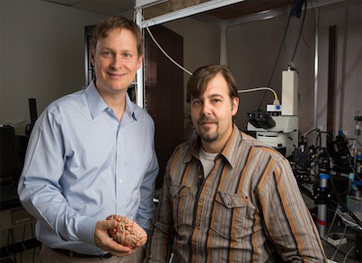UH Researchers Working to Slow Down Memory Loss in Alzheimer’s
Supported by $100K Alzheimer’s Association Grant, Initial Results Published in PLoS ONE
Neuroscientist Jokūbas Žiburkus (right) and pharmacologist Jason Eriksen (left) have joined forces in hopes of restoring nerve cell function in the early stages of Alzheimer’s disease. (Photo by Thomas Campbell)Seeking to pinpoint Alzheimer’s disease at its earliest manifestations, researchers at the University of Houston (UH) are working toward ways to slow down memory loss that would allow patients to better cope with this devastating disease.
By looking for the earliest breakdown of nerve cells in the brain, UH neuroscientist Jokubas Ziburkus and his team hope to restore nerve cell function in the early stages of Alzheimer’s disease, ultimately correcting the dysfunction with new therapeutic targets. Ziburkus, whose research is supported by a $100,000 New Investigator Grant from the Alzheimer’s Association, is collaborating with UH pharmacologist Jason Eriksen. Their results were recently published in PLoS ONE, an open access peer-reviewed scientific journal published by the Public Library of Science.
Ziburkus, an assistant professor of biology and biochemistry at UH, first became interested in the relationship between epilepsy and Alzheimer’s. He was particularly struck by research suggesting that a much higher number of Alzheimer’s patients than previously thought suffered from seizures. After more investigation, he says he was amazed by the lack of functional electrophysiological studies in Alzheimer’s models. As an electrophysiologist, he saw a need and an opportunity and decided to apply his expertise in epilepsy research to study functional alterations in Alzheimer’s.
He began collaborating with Eriksen, an assistant professor of pharmacology at UH. Together, they found a novel dysfunction in Alzheimer’s disease that they anticipate will lead them to new, unexplored, potentially therapeutic interventions.
Their research looks at nerve cells in the hippocampus, which is the part of the brain important for memory function and formation, as well as one of the first regions affected by Alzheimer’s disease. In particular, they are looking at amyloid-beta (Abeta), a protein fragment linked to Alzheimer’s disease that accumulates in the hippocampus during early stages of the disease and is believed to cause dysfunction in this region.
“One of the major pathological hallmarks of Alzheimer’s disease is the progressive accumulation of Abeta proteins in the brain, and this accumulation disrupts nerve cell function,” Ziburkus said. “Using a rare combination of fast, functional imaging and challenging electrophysiological recordings, we discovered dysfunctional neural circuit activity and a severe inability of inhibitory neurons to produce electrical impulses in the hippocampus. Our new data suggests that the processing of information is greatly impaired or lost because of disruptions in specific cells and circuits in the hippocampus, potentially resulting in a failure to properly encode new memories. We seek to further identify the early onset of these functional changes in the cells and brain circuits key for memory formation. This work will provide new mechanistic insights into the early cell and network dysfunctions involved in dementia.”
To do this, Ziburkus says they needed to understand how neural networks function, approximating activities of almost every individual neuron. The team’s approach was to monitor activity in individual neurons and neuronal circuits, to get a better understanding of the mechanisms underlying dementia. Using electrophysiology, they were able to record a specific subset of neurons, called inhibitory cells, in the hippocampus. They also performed imaging experiments using voltage-sensitive dye, which is made up of fluorescent molecules that can report changes in electrical potential of individual neurons and neural circuits.
Through these electrical recordings of nerve cell activity, they focused on a region of the hippocampus known as the dentate gyrus thought to contribute to the formation of new memories. They found that the main type of excitatory cells in this region had unusually strong responses to signals from other neurons. The researchers believe this is caused by dysfunction in the nerve cells that normally inhibit such activity. Subsequently, they found impaired mechanisms believed to underlie short-term memory and activity that exhibited epileptic-like characteristics.
“For now, our work is revealing a new understanding of functional alterations in neurons and nerve cell networks that may underlie some of the pathology of Alzheimer’s disease, such as memory loss and seizures,” Ziburkus said. “These new mechanisms can lead us to a better understanding of the early dysfunctions in dementia through identification of new cellular mechanisms and effective ways of controlling nerve cell activity. Our ultimate hope is that this will lead to novel therapeutic approaches to treating the disease.”
A testament to the success of their collaboration is the joint paper in PLoS ONE, which included four UH student authors who contributed significantly to various experimental and analytical aspects of the studies. Led by senior co-authors Ziburkus and Eriksen, the student contributors were recent Ph.D. graduates Anupam Hazra and Feng Gu and recent B.S. graduates Ahmad Aulakh and Casey Berridge. An abstract of the paper, titled “Inhibitory Neuron and Hippocampal Circuit Dysfunction in an Aged Mouse Model of Alzheimer’s Disease,” can be found at http://www.ncbi.nlm.nih.gov/pubmed/23691195.
- Lisa Merkl, University Communication
